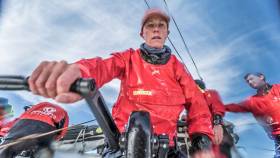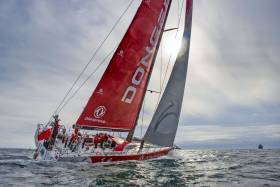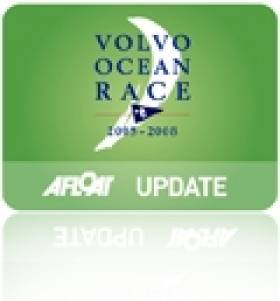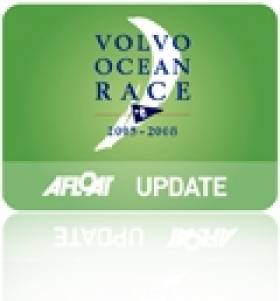Displaying items by tag: Dongfeng Race Team
Women Join Dongfeng Crew For 2017-18 Volvo Ocean Race
#VOR - Dongfeng Race Team has announced two women for its crew as preparations ramp up for the 2017-18 Volvo Ocean Race.
Dutch Olympic sailor Carolijn Brouwer, who competed in the previous VOR with the all-female Team SCA, will be joined by France’s Marie Riou, a fellow Olympian and a multi-time Nacra 17 world champion.
They will sail alongside previously announced crew members Jérémie Beyou, Stu Bannatyne and Daryl Wislang under returning skipper Charles Caudrelier for the Chinese entry that secured third place in its first VOR in 2014-15.
Caudrelier said Brouwer was a given for his crew “because she beat us many times during the last race when she helmed Team SCA in the in-port races.
“We all knew that she is a good helm and she has a big Olympic past and I really respect that. But her Olympic campaigns have turned her into a very fast driver and she knows where to put the boat.”
Riou, meanwhile, brings a wealth of Olympic sailing and offshore racing experience to the team, along with her strength and “good spirit”, the skipper added.
Brouwer and Riou’s selection marks the first move under last year’s rule change to encourage mixed crews in the next edition of the race, as previously reported on Afloat.ie.
It’s not the only first for Dongfeng, which last month released footage of its refitted Volvo Ocean 65 in testing off Lisbon — where the race fleet is being readied at the VOR’s Boatyard facility ahead of the race start in seven months’ time.
An eighth boat is in the final stages of construction at Persico Marine in Italy for new campaign Team AkzoNobel.
Drone Footage Of Dongfeng’s Refitted Volvo Ocean Race Contender
#VOR - Dongfeng Race Team is back on the water and training is well underway for the returning Chinese campaign in the 2017-18 Volvo Ocean Race less than eight months away.
To mark the occasion, some incredible drone footage of the refitted Volvo Ocean 65 has been released as the team hit the water off the coast of Lisbon.
As the remaining boats continue to undergo the €1-million refit process, Charles Caudrelier is the first skipper out on the water with his upgraded Volvo Ocean Race challenger.
The French skipper has yet to announce his sailing squad for the next edition of the race, but the team have said it will once again feature a mixed Chinese and western crew — and will also take advantage of new rules designed to encourage female sailors to take part.
Caudrelier has been working hard for months on this new campaign that he hopes will build on the team’s impressive third place on debut in the Volvo Ocean Race in 2014-15.
Dongfeng Race Team are backed by Dongfeng Motor Corporation, one of the largest automobile manufacturers in China.
Refit Completed On Dongfeng’s VOR Challenger
#VOR - Dongfeng Race Team’s Volvo Ocean 65 is the first boat to emerge from its refit process ahead of this year’s Volvo Ocean Race.
The VOR website has details of the boat’s €1 million overhaul at Lisbon’s Boatyard, which has seen more than 500 items on board either augmented or upgraded.
Due for launch today (Tuesday 17 January), the boat must first undergo a rigorous commissioning and calibration regime to optimise its new electronics, deck gear and rigging before it can set sail with skipper Charles Caudrelier and crew on board for their first training sessions.
#VOR - Musandam-Oman Sail skipper Sidney Gavignet has been added to Dongfeng Race Team's crew as they prepare for the start of Volvo Ocean Race Leg 7 from Newport to Lisbon this weekend.
Gavignet comes fresh off the MOD70 trimaran's smashing of the Round Ireland speed sailing record last week to stand in for fellow Frenchman Eric Peron, who will return for the final two legs.
It also marks the latest in a series of crew rotations by skipper Charles Caudrelier on the Leg 6-winning yacht, after Kerry sailor and fellow VOR vet Damian Foxall lent his experience on Leg 5.
“He’s a Volvo Ocean Race expert, and I’ve been wanting to sail again with him for a long time," said Caudrelier of Gavignet. "We sailed together 12 years ago and it went really well so I can only hope this leg will be just as good.”
In other crew change news, Team Brunel have added CAMPER sailor Adam Minoprio to their line-up for the remaining legs.
The youngest ever sailor to be a match-racing world champion "could just make the difference in the last three short legs," said skipper Bouwe Bekking.
And Team Vestas Wind will welcome Australian sailor Tom Addis and Simeon Tienpont, Dutch veteran of the most recent America's Cup-winning crew, when their yacht is ready to rejoin the race in Lisbon for Leg 8 next month.
Their return to the fleet after their devastating grounding in the Indian Ocean late last year is sure to bring more eyes to the action as the finish line draws closer.
No one could be more pleased than VOR chief Knut Frostad, who tells the Yacht Racing Forum about the race's improving commercial position in a still-tough economic climate.
Another happy man is Ian Walker of Abu Dhabi Ocean Racing, who feels his team's performance in the race so far is set to eclipse the "injustice" of setbacks during the 2011-12 race, which included a broken mast in the first race, and limping towards Brazil in the Auckland-to-Itajaí leg with hull damage.
But as he tells Yahoo! News, the Azzam skipper is hesitant to call their current performance "revenge".
"It's like a Formula One race. If you haven't got the car, never mind how good the driver is. We had the potential to win but we never had the opportunity to demonstrate it."
Walker adds: "The race is not over yet at all. But we are in a strong position, a position where we don't have to beat Dongfeng in every leg. Which is important."
Next Step For Dongfeng's First Volvo Ocean Race Trainees
#VOR - Three months after China's Dongfeng Race Team was confirmed as an entrant in the upcoming 12th edition of the Volvo Ocean Race, the first eight members of the team's training squad have been named following a tough selection process.
Ying Kit Cheng, Xue Liu, Yiran Zhang, Liang Wu, Jin Hao Chen, Jiru Wolf Yang, Sheng Shen and Ming Liu made the cut from a 20-strong group put through what the VOR website called "a challenging series of tests" at Sanya's Serenity Marina.
Next for this 'elite eight' will be a week of fitness and sea survival training, including a test race from Hong Kong to Sanya to assess their boat-handling skills.
But there's no guarantee that all of these names will end up on the final team that sets sail on their VOR 65 from Alicante this coming October, marking China's third challenge of the round-the-world yachting endeavour.
And another group of candidates will have the opportunity to prove their mettle in a second round of trials on 8-9 February.
The VOR website has more on this story HERE.




























































